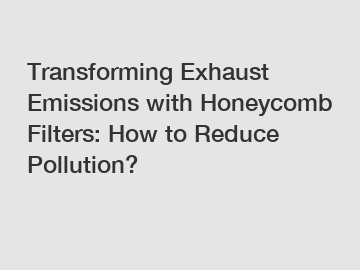Transforming Exhaust Emissions with Honeycomb Filters: How to Reduce Pollution?
Transforming Exhaust Emissions with Honeycomb Filters: How to Reduce Pollution?
In order to effectively reduce pollution and transform exhaust emissions, experts and engineers have turned to honeycomb filters. These innovative filters have proven to be highly efficient in capturing harmful pollutants emitted from vehicles and industrial processes. By understanding the process behind honeycomb filters and their environmental impact, we can unlock the potential of these filters in reducing pollution levels.
Honeycomb filters are composed of a structured arrangement of cells, resembling the shape of a honeycomb, made from high-quality ceramic materials. These filters act as a barrier, capturing and trapping harmful particulate matter and gases within their porous structure. As exhaust gases flow through the filter, the honeycomb structure provides a large surface area for the pollutants to adhere to. This surface area is further enhanced by the presence of catalysts, such as platinum and palladium, which facilitate chemical reactions that convert harmful gases into less toxic compounds.

The effectiveness of honeycomb filters lies in their ability to remove both particulate matter and harmful gases from exhaust emissions. Particulate matter, such as soot and ash, can cause respiratory problems and contribute to air pollution. By capturing these particles, honeycomb filters help reduce the levels of harmful particles released into the atmosphere. Additionally, the catalysts present in the filters help break down harmful gases, such as nitrogen oxides and carbon monoxide, into less harmful substances, minimizing their adverse effects on the environment and human health.
The use of honeycomb filters in various industries has led to significant reductions in pollution levels. In the automotive sector, for example, the widespread adoption of catalyzed honeycomb filters in vehicles has played a crucial role in reducing emissions of nitrogen oxides by up to 90%. This has contributed to improved air quality and a healthier environment for both urban and rural areas. Similarly, industrial processes, such as power generation and manufacturing, have benefited from the integration of honeycomb filters, resulting in reduced emissions of harmful pollutants and a more sustainable approach to production.
Moreover, the widespread implementation of honeycomb filters can have a global impact on environmental conservation efforts. With increasing awareness of the impacts of pollution and climate change, governments and regulatory bodies are imposing stricter emission standards. Honeycomb filters offer an effective solution to meet these stringent requirements and help industries transition towards a greener future. By reducing pollution at its source, these filters contribute to the overall mitigation of climate change and preservation of ecosystems.
In conclusion, honeycomb filters provide a transformative solution to reducing pollution and transforming exhaust emissions. Through their efficient capture of particulate matter and breakdown of harmful gases, these filters play a crucial role in improving air quality and promoting sustainable practices. The integration of honeycomb filters in various industries showcases their potential in addressing the global challenge of pollution. As we strive for a cleaner environment, honeycomb filters offer a tangible solution to reduce pollution levels and protect our planet for future generations.
If you are looking for more details, kindly visit Custom High Silica Glass Fiber Filters, zirconia ceramic foam filter, Ceramic Foam Filter Manufacturers.

Comments
0